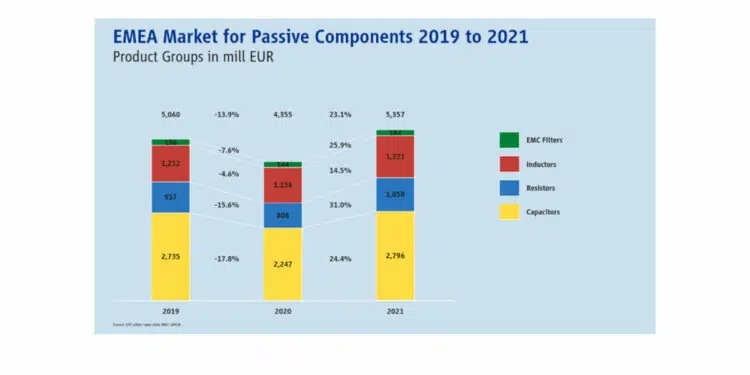The European Passive Components Industry Association (EPCIA) published its recent newsletter with European (EMEA) market development for passive components from 2019 to 2021.
EPCIA represents and promotes the common interests of the Passive Components Manufacturers, E&E Associations and Technological Research Institutes active in Europe to ensure an open and transparent market for Passive Components as part of the global marketplace.
Based on the aggregated results of the common European Passive Components Statistics (EPC-eStat), the markets developed as follows:
The EMEA Passive Components market in 2019 had a size of EUR 5.1 bn. In 2020, the first year of the COVID-19 pandemic, total sales fell by 13.9%,
mainly due to associated lockdowns and production stops in the second quarter of 2020. All product groups recorded a sales decrease: Capacitors (-
17.8%), Resistors (-15.6%), Inductors (-4.6%) and EMC Filters (-7.6%). In 2021, the EMEA Passive Components market climbed a whopping 23.1% to
EUR 5.4 bn, a new all-time high.
Product Groups
With a share of 52% in 2021, Capacitors were the largest product group in the Passive Components Market in EMEA. After the sharp drop of 17.8% in
2020, the Capacitors market recovered strongly in 2021. With a market size of almost EUR 2.8 bn, it even surpassed the record level of the pre-Corona
year 2019.
Resistors accounted for 20% of the EMEA Passive Components Market in 2021. In the pandemic year 2020, sales of Resistors dropped 15.6% to a level of
EUR 0.8 bn. Driven by a strong demand for Chip/SMD types (up 41.3% YoY), the Resistors market climbed to a volume of EUR 1.1 bn in 2021 which is higher than in pre-Corona year 2019, but not as high as in the record year 2018.
Inductors represented the second largest product segment among Passive Components in the EMEA market with a share of 25% and a volume of EUR 1.3
bn in 2021. The pandemic-related decline of 4.6% in 2020 was relatively modest, followed by a decent recovery of 14.5% in 2021. Sales growth over both
years from 2019 to 2021 was above average.
Like all other product groups, the market for EMC Filters also recorded a significant decline in 2020, namely by 7.6% to EUR 144 mill. This was followed
by very strong growth of 25.9% to EUR 182 mill in 2021.
Main European Market Segments
The Automotive sector represents a good half of the total Passive Components market in EMEA and was hit hard by the pandemic crisis in 2020, as was the
Industrial market as the second largest segment with a share of one third. Both market segments could recover strongly by more than 20% each in 2021.
older stats can be found here: European Market Development for Passives Shows Stable Growth in 2016-2018 (passive-components.eu)






























